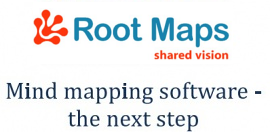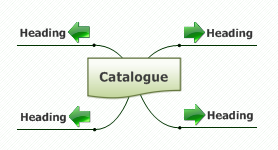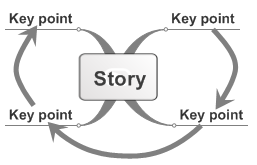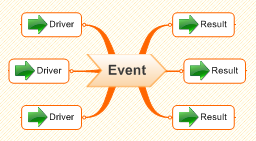Root maps
This article proposes some conventions on formats for common mind maps used in organizations, with a view to enhancing their use by using familiar patterns. It does not suggest that flexible, free-form mapping should be dropped. Its author has pointed out that “formality versus flexibility is not an either/or situation – both are needed, at different times and for different purposes.”
It is copied from an original white paper by Nick Duffill of Harport Consulting under the terms of the license by which that paper was released, and he has approved its appearance here.
This work (that is, the article on this specific page of WikIT) is licensed under the Creative Commons Attribution-No Derivative Works 2.5 UK: Scotland License. To view a copy of this licence, visit http://creativecommons.org/licenses/by-nd/2.5/scotland/ or send a letter to Creative Commons, 171 Second Street, Suite 300, San Francisco, California 94105, USA.
Contents
Purpose[edit]
This paper is written for users of “mind mapping” software, and asks the question “Are Mind Maps® the best way to use mind mapping software, or are we missing something?”
It proposes that a “mind map” is only one of a set of root designs, and that the value of mind mapping software within organisations can be enhanced by adopting easily recognised map layouts.
Market-positioning of mind mapping software[edit]
“Mind mapping” software is one of only a handful of electronic tools that have created a new space among the de-facto productivity suite of e-mail, word processing, spreadsheets, presentation and database tools. With probably over 2 million users, and over 50 vendors in the market, the uptake of mind mapping software shows few signs of decelerating; new products are still being introduced, indicating a belief that untapped potential and space for new ideas still exists.
Mind mapping is often associated with brainstorming and creativity. A quick glance at the vocabulary and culture around Mind Mapping confirms this handy label, despite its origins as a note-taking method. However, this label under-sells the capabilities of mind mapping software, as repeatedly demonstrated by its users through increased personal and team productivity. What needs to happen for these benefits to be translated to a wider audience?
Advances in the mind mapping software market are mainly technology-driven. The quality and capabilities of software have improved dramatically over the last fifteen years, but there have been almost no corresponding advances in the art of creating and using maps, especially in an organisational setting. We are applying a lot more horsepower to the same basic concept of individualistic expression. Many developers have tried to move away from an explicit connection with “Mind Mapping”, but it remains the term of choice when searching for software. The term “mind map” is coming to mean much more than “Mind Map”. Are these visualisation techniques really at their peak, leaving only the technological dimension to explore? Is it right to assume that because technology makes it possible to share maps, then the maps themselves are fit to share? Are maps so intuitive that we do not need to consider the impression they might make on new audiences? Or could we be using these tools more effectively?
Business and organizational document patterns[edit]
To make business and organisations run smoothly, we are accustomed to a certain amount of formality. A written letter has specific types of information in the right places; organisation charts usually work in the same way; company accounts have consistent layouts, and most people recognise that a flow chart represents a process. These small conventions mean that we have a good idea of the purpose of many types of document or diagram, and what we are intended to do with them, before we begin to absorb the detail.
Mind map patterns?[edit]
But the only well-established convention for a “mind map” is that it is some kind of snapshot of the subject indicated at the centre of the map. Every map can be unique, and most of them need a commentary when shared beyond the circle of authors. This lack of common expectations means that the readers of a map (as opposed to its authors) cannot anticipate what to look for, what they will find, where it will be, and what they are expected to do with it. Worse, the reader may not be aware of this convention; they may not understand that a mind map is a personal construct, and may think that they are just being rather slow if they don’t “get it” when everyone else seems to. Their only hope is that the map is trivial enough to be self-evident. Since most business issues are non-trivial, it is not surprising that mind mapping often does not grow beyond small peer groups. In reality, a mind map is often evidence of the thinking process rather than the presentable result. This can be very difficult for authors to perceive, for the same reason that it is difficult to reliably proof-read your own writing. The author and non-authors of a map see two very different things when they look at the same map. The author sees the big picture that is, truth be told, mostly still in their head rather than on the page, while the reader sees a bewildering array of fragments. This explains why the best way to get “buy-in” for a map is to involve the audience in its creation. It then becomes a reminder of the consensus that emerged during its development, rather than an independent description.
The dominance of hierarchy[edit]
Another objection to the “over-use” of mind mapping tools is that much of the real world is nonhierarchical, so attempts to structure it into a tree are doomed. While this is true at one level, it is a misapprehension at another. Only a small part of everyday business involves dealing with neatly structured information. A great deal of it includes working with intangibles such as intentions, opinions, opportunities, problems, consequences and dilemmas, to name but a few. A hierarchical approach is a valuable tool for analysing a situation, rather than a literal model of the situation itself. Maps are very good at summarising, prioritising and focusing, which are key skills in business, regardless of the underlying structure of the issue. There is no absolute requirement for the subject itself to be hierarchical.
Mind mapping as a process[edit]
A key benefit of using mind mapping software lies in the process of developing a maps, which is just as valuable as the resulting map, if not more so. Maps should rarely reflect the scale of effort that went into building them; simple, concise maps are more usable than complex ones, but are naturally much harder to create. Big and messy maps are quick to create. Many users of mind mapping software use it to support divergent thinking. Fewer people use it to converge again on key concepts and messages that they can communicate to others, which is a tougher but more rewarding discipline.
“Normalizing” mind map content[edit]
Most mind mapping software products include the export of a map to a familiar format, such as a word processor document. This is partly for reasons of interoperability with de facto data formats, but also for reasons of interoperability with de facto mindsets. In an ideal world, users of mind mapping software would be able to share their work in its native format, so that it remains open to improvement and re-use, and that the advantages of visualisation are not lost to normalisation. Maps are never finished, only orphaned or superseded. Exporting a map to a linear format is a quick way to orphan both it and the thinking processes behind it at the click of a button.
To overcome these challenges and help to strengthen the value of mind mapping software within organisations, the primary goal that the Root Maps method aims to address is clarity of purpose. Today, when a map is shown to a colleague who was not involved in its creation, they might think “Oh, it’s one of those mind map things”. It would be a big step forwards if they were able to glance at a map and say “Ah, it’s a presentation” or “Good, it’s a plan”. Rapid recognition of the purpose of a map moves the dialogue forward in a new relationship between author and audience, where the visualisation is exploited instead of explained – or even excused if things are not going well.

|

|

|

|

|
| Catalogue | Story | Plan | Event | Mind map |
The five root map designs
The goal of each design is to enhance:
- Recognition – how users can easily identify the design on which the map is based
- Purpose – what business purpose the map is intended to support
- Structure – how the subject is modelled in a tree
- Context – creating expectations of what will be in there and where it will be
The first four root map designs are simple enough to be understood by anyone – mappers and nonmappers alike, so that conversations can revolve around outcomes rather than decoding the map itself. The fifth type is an unrestricted “mind map”, without any preconceived format, leaving a space for free-form maps.
Note that the designs do not include any representation of processes, patterns commonly found in business. The flowchart is a well-established tool for depicting processes, and most mind mapping software tools are slower at creating flowcharts (and produce less usable results) than dedicated flowchart tools. Mind mapping tools are not able to “model” processes in the same way that process modelling software can. For these reasons, process flows are not included in the root map designs.
Benefits[edit]
Adopting some common designs of map has many advantages, for individuals and organisations:
- The purpose of a map can be quickly recognised from its layout and visual style. This is akin to recognising that a flow chart represents a process before reading the detail, and makes a big difference to the reader’s expectations.
- Non-mappers can be briefed on how to interpret and follow a small repertoire of map designs. This removes the need for every map to be individually explained to ensure that is it correctly understood. The author can simply refer the reader to an independent source that explains the basic design.
- Managers and team leaders who have mind mapping enthusiasts in their teams can steer them towards a consistent approach that increases the usability and accessibility of their work.
- Users of mind mapping software whose managers or colleagues are only vaguely interested can better demonstrate the value of their technique. Instead of trying to make the case for mind mapping or mind mapping software, they can focus on the case for visually communicating business situations, which is more likely to appeal to their managers.
- Collaborative mappers can get past gridlock or stale-map situations by agreeing the terms of reference for the design and purpose of their maps.
- Consultants who like to use mind mapping software (and many do) have a ready-made way to brief their clients on the tool and technique, especially in the critical area of the relationship between the client and the client’s boss. Making their work accessible to higher levels within the client’s organisation is a vital strategy.
- Developers of mind mapping software have an external resource to guide the take-up of their solution, taking it further than basic creativity and brainstorming, and helping product champions to demonstrate benefits within the customer’s organisation.
- The root map designs are cross-platform and cross-vendor, and are not tied to a particular software tool. Some tools may have features that make them better suited than others to implementing the root maps, which offers a way for users to objectively evaluate the features and functions of mind mapping software.
- The flexibility and freedom enjoyed by mind mappers is not restricted by the presence of a framework, but is better identified within it. This reduces marginalisation, by setting appropriate levels of expectation for accessibility beyond the original authors.
- Organisations can adapt and customise the root map designs for their own particular needs. The key objectives are recognition and consistency, not slavish adherence to rules.
Arguments against[edit]
What are the disadvantages of a disciplined approach? You could argue that freedom and creativity are restricted by “rules”. But this is a good thing if we are trying to communicate, as individualistic approaches often leave the audience trying to decipher the message from the medium. Consider the indulgences often blamed on Microsoft PowerPoint; even though the underlying cause is poor technique, the tool itself usually takes the blame. The medium is the message. Authentic free-form mind maps still have a place within the Root Maps framework, provided they are identified as such, and everyone know what to expect of them (or not).
Conclusion[edit]
Of course, many users of mind mapping software have discovered some of these patterns for themselves. But the visual design of a map and its decoration are often used stylistically rather than to encode the purpose of the map. The Root Maps method proposes that when maps are used for certain objectives, some styling and branding is sacrificed in favour of consistent and recognisable designs that help to identify the business purpose of the maps.
The Root Map designs are licensed under the Creative Commons “attribution sharealike” model, meaning that they can be copied and modified by users and vendors. The goal is for the community, which has a vast amount of accumulated knowledge and practical experience of what works and what doesn’t, to improve the designs to help to increase the value of mind mapping software in organisations of all kinds.
Copyright of this article[edit]
This work (that is, the article on this specific page of WikIT) is licensed under the Creative Commons Attribution-No Derivative Works 2.5 UK: Scotland License. To view a copy of this licence, visit http://creativecommons.org/licenses/by-nd/2.5/scotland/ or send a letter to Creative Commons, 171 Second Street, Suite 300, San Francisco, California 94105, USA.
| For free information about the hundreds of visual thinking tools available, visit the Visual Thinking Center |







